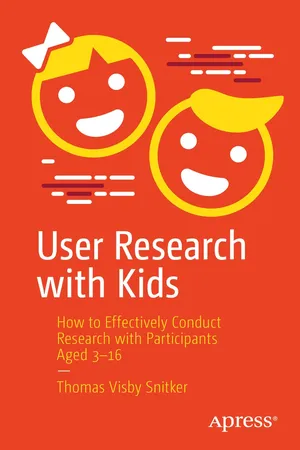
User Research with Kids
How to Effectively Conduct Research with Participants Aged 3-16
- English
- ePUB (mobile friendly)
- Available on iOS & Android
User Research with Kids
How to Effectively Conduct Research with Participants Aged 3-16
About This Book
If you are a designer, producer, marketer, or researcher creating products for children, it is essential that you are aware of the key differences between children and adults when it comes to user journeys. While children might speak the same language as adult users, what they are actually communicating can be completely different. User Research with Kids explores these differences and more.
Author Thomas Visby Snitker walks you through how to best approach user research with children through the processes of conceptualization, design, prototyping, and eventually the launch. Adults who research kids' experiences venture into a familiar yet foreign land where the inhabitants speak a different (yet familiar) language and have different behavioral norms and values. It is important for researchers to decipher and understand this language. Including children in the process will lead to better targeted and better designed products, and User Research with Kids will help you attain this goal.
Snitker's useful insights in this book will help professionals and students in all sectors of research, design, and innovation. User Research with Kids will teach you how to better work with children using key approaches, such as understanding what play is and holistically measuring experience from a child's cognitive perspective. Apply research rigor and best practices for your next product launch, and expand your user understanding with User Research with Kids.
What You Will Learn
- Incorporate play and best practice to a research project with kids as (or among) the participants
- Approach, scope, prepare, execute, and report research projects
- Choose the method and approach that is best suited for the needs of your project and stakeholders
Who This Book Is For Designers, producers, marketers, or researchers with kids as the audience, or students.
Frequently asked questions
Information
Table of contents
- Cover
- Front Matter
- 1. Understanding Kids and Their Experiences
- 2. How (Not) to Ruin Perfectly Good Research in 18 Steps
- 3. Succeed Through Better Research Practice
- 4. Toward Infinity and Beyond: A KX Score
- 5. What to Score
- 6. How You Can Use the Kids’ Experience (KX) Score
- 7. Challenges and Opportunities in Research with Children as Seen by Practitioners
- 8. Summary
- Back Matter